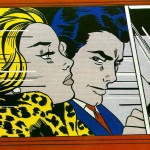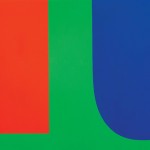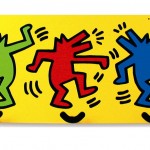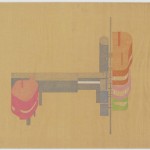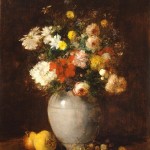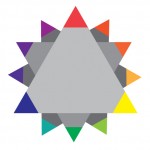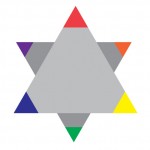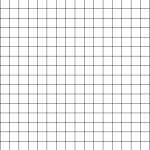Critique:
- Chromatic Gray Studies #1 & #2
- Muted Color Studies #1 & #2
Discussion
Review Color Concepts (Class 16)
- Lichtenstein
Prismatic Color Studies:
- These colors are as pure a hue as possible using paints. Essentially these are hues that are straight from the tube. Please work with primary (red, yellow, blue) and secondary (orange, violet, and green) hues and their nearest neighbors (red-orange, yellow-orange, yellow-green, blue-green, blue-violet, red-violet). Do not use browns, blacks, grays or white.
- The value of your prismatic colors is determined by its place on the color wheel not by adding darks or whites. Squint your eyes and look at the color wheel. The lightest colors are yellows, the darkest colors are violets. A prismatic study in high key will be created with yellows. A prismatic study in low key will be created with violets.
Prismatic Color Studies – Exercise #1:
- Make a 6×6″ gouache, painted-paper collage using at least six shapes. All colors should be PRISMATIC with a BROAD value range (light and dark) from a BROAD range of hues (colors). The entire surface of your composition should be covered with paint.
- Use scrap pieces of bristol to create your painted paper shapes. Cut these out with scissors or exacto knife.
- Arrange your shapes until you achieve a unified composition and then carefully glue down your pieces.
Prismatic Color Studies – Exercise #2:
- Make second 6×6″ gouache, painted-paper collage using at least six shapes. All colors should be PRISMATIC with a NARROW value range (high or low key). This means you will either create a composition with prismatic yellows (high) or prismatic violets (low). The entire surface of your composition should be covered with paint.
- Use scrap pieces of bristol to create your painted paper shapes. Cut these out with scissors or exacto knife.
- Arrange your shapes until you achieve a unified composition and then carefully glue down your pieces.
Homework
- Finish ALL Saturation Studies:
Make sure each composition is neatly mounted and protected with tracing paper or clean drawing paper.- Chromatic Gray Studies #1 & #2
- Muted Color Studies #1 & #2
- Prismatic Color Studies #1 & #2
- Come PREPARED to work in class on the Freestudy #1 (see Assignment #4 – Section 3)
Bring in a library of materials (paper, photos, magazine images, fabric, candy wrappers, sandpaper, wrapping paper, etc. ) that have a broad range of value, saturation, and hue. Bring enough “stuff” to fill a shoe box. Come prepared to explain the value, saturation, and hue of each scrap. - Materials: same as this week, plus scrap box!


